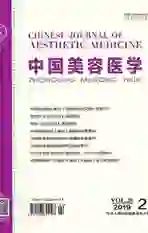上前牙美学区种植修复使用角度基台的三维有限元分析
2019-03-13石平许哲李哲王淼常晓峰杜良智
石平 许哲 李哲 王淼 常晓峰 杜良智
[摘要]目的:探讨分析上颌前牙美学区种植修复使用角度基台的影响因素。方法:建立仿真模型,运用三维有限元法(Finite Element Method,FEM)分析4.0mm直径、10mm和13mm长度(Length,L)的种植体连接不同角度基台(0°、10°、20°、30°)的生物力学性能。结果:随着基台角度增大,种植修复系统、皮质骨、松质骨各部位应力及应变递增,分布更集中;与0°角度基台对比,使用 30°角度基台可增加34.8%(L13mm)、39.5%(L10mm)的皮质骨区最大应力,增加18.1%(L13mm)、39.6%(L10mm)的松质骨区最大应力;同时,皮质骨区最大应变增加64.0%(L13mm)、64.4%(L10mm),松质骨区最大应变增加23.9%(L13mm)、57.2%(L10mm);种植体长度增加3mm,皮质骨和松质骨周围最大应力能减少10.6%~18.2%,皮质骨区的最大弹性形变减少2.1%~2.2%,松质骨区的最大弹性形变减少17.9%~25.4%;负载下,各组模型在连接接近20°角度基台时,皮质骨应变已接近骨弹性阈值。结论:基台角度越大,种植系统及牙槽骨所受应力、应变越大越集中;上前牙区4mm直径种植体建议连接小于20°的角度基台,以减少局部皮质骨应力应变;增加种植体长度一定程度上可减小应力和分散应变。
[关键词]角度基台;种植;有限元法;上前牙区;美学区
[中图分类号]R782.12 [文献标志码]A [文章编号]1008-6455(2019)02-0106-04
Abstract: Objective To explore influences of angled abutments connected with implant restoration in anterior maxilla aesthetic area. Methods Established simulation models and utilized finite element method (FEM) analysing biomechanical properties of implants (Diameter, 4.0 mm; Length, 10mm and 13mm) with different angled abutments(0°,10°,20°,30°). Results With the increase of abutment angle, values of stress and strain of all parts increased, and distributions of stress and strain of all parts became more concentrated; Compared with 0°abutment, connected with 30° angled abutments lead to increases in stress, which were 34.8%(L13mm),39.5%(L10mm)in cortical bone and 23.9%(L13mm),57.2%(L10mm)in cancellous bone, and increases in strain, which were 64.0%(L13mm),64.4%(L10mm)in cortical bone and 23.9%(L13mm),57.2%(L10mm)in cancellous bone. Cortical bone elastic deformations may exceed the bone elastic threshold when angle of abutments got bigger than 20 °.An increase of 3mm in implant length lead to a 10.6%~18.2% decrease of stress in cortical and cancellous bone, and a 2.1%~2.2% decrease of strain in cortical bone. Conclusion With abutment angle increase, stresses and strains got bigger and more concentrated in the abutment, cortical and cancellous bone; Abutments with angle less than 20° were safer for implant(Diameter 4mm) restorations in anterior maxilla area regarding stress and strain distribtion in cortical bone. Increases of the implant length may helps to the distribution of force to a certain extend.
Key words: angled abutment; implant; finite element method(FEM); anterior maxilla; aesthetic area
上前牙美學区域牙齿缺失进行种植修复时常需使用角度基台, 研究表明,种植修复体连接角度基台时会使得局部应力更集中,更有可能导致种植体周围骨吸收和远期种植修复的美学效果及使用时间[1]。目前,关于上前牙美学区种植修复使用角度基台的临床研究较少[2]。为探索上颌前牙美学区种植修复使用角度基台的影响,本研究采用三维有限元法(Finite Element Method ,FEM),通过计算机及相关软件建立三维仿真模型模拟负载,进行相关生物力学性能实验评估,研究上颌前牙缺牙区种植单冠修复使用不同角度的基台进行修复后,负载下种植系统各部件及周围骨的应力和应变情况,为临床上前牙区使用角度基台提供理论参考。
1 资料和方法
运用Solidworks等软件建模,种植体(直径4.0mm,长度L10mm和L13mm,螺距0.83mm,螺纹深度0.5mm)、基台(0°,10°,20°,30°)及配套的牙冠及皮质骨(嵴顶区厚度为2mm)和松质骨,导入Ansys workbench 14.0中运用FEM,以von-Mises 应力峰值(von-Mises peak stress,σvM)、张力应变峰值(max principle peak elastic strain,εmax)及分布区域为指标,各部位各材料力学参数,见表1。种植体、基台的应力屈服强度(Yield Strength)为800MPa,皮质骨为104MPa,松质骨为82MPa[3-6];骨阈值理论认为骨组织受力发生形变,形变增加1%即为10 000μstrain,1 500~4 000μstrain为其功能性应变范围,大于4 000μstrain会发生病理性改变[7-8]。
2 结果
研究模型显示,负载下种植修复系统各个部件及颌骨的皮质骨和松质骨呈现不同层次的应力和应变分布,负载下牙冠部咬合力能通过基台-种植体界面及种植体-骨界面逐层传导至种植体周围皮质骨和松质骨(表2)。
实验结果显示,种植修复体的负载可通过牙冠、基台、种植体传导至周围皮质骨及松质骨。总体上,von-Mises 应力峰值σvM分布在近洞缘处的基台、种植体及颌骨的唇侧和腭侧;相对于基台,种植体负载较少,种植体应力主要分布在其颈部近嵴顶区,体部和根部应力分布较少;颌骨的主要负载区为种植体颈部的皮质骨区域,根端松质骨区承担应力最小,但应变较大,仅次于皮质骨。随着基台角度增大,基台、颌骨和种植体主要负载区域基本不变,应力值增大,高应力值分布面积增大(表 2~3)。这在基台上体现尤为明显,连接30°角度基台负载后,基台的von-Mises 应力峰值增大,峰值分布的区域明显增大。
由于种植修复体、皮质骨和松质骨的弹性模量呈阶梯下降(见表1),负载下颌骨区域发生的弹性形变最大。随着基台角度增大,颌骨的应力应变均增大(表3)。表2示与0°角度基台对比,使用30°角度基台,皮质骨区σvM增加34.8%(L13mm)、39.5%(L10mm),松质骨区σvM增加18.1%(L13mm)、39.6%(L10mm);表3示,皮质骨区εmax增加64.0%(L13mm)、64.4%(L10mm),松质骨区εmax增加23.9%(L13mm)、57.2%(L10mm)。其中皮質骨的应变,L10组εmax(20°)=3800μstrain、εmax(30°)=4230μstrain, L13组εmax(20°)=3720μstrain、εmax(30°)=4148μstrain,皮质骨形变已接近或超过骨弹性形变阈值,但松质骨均未超过阈值。
此外,表2、3提示,增加种植体长度能减少角度基台带来的不利影响。种植体长度增加3mm,皮质骨和松质骨周围最大应力能减少10.6%~18.2%,皮质骨区的最大弹性形变减少2.1%~2.2%,松质骨区的最大弹性形变减少17.9%~25.4%。
3 讨论
上前牙缺牙区种植修复的风险较高,临床上常建议使用直径4.0mm的种植体进行上颌中切牙区种植修复[12]。同时,由于组织解剖形态或种植位点不理想,后期修复时常不可避免地使用角度基台[13]。目前不同种植修复系统配备的原装角度基台的最大角度各异,关于角度基台的安全角度范围也存在争论,一些学者认为可以使用30°以上的角度基台行种植修复[14];也有学者建议最大角度控制在25°[9,15-16],甚至最好在20°以下[3,10]。
本实验发现,负载下种植修复体及周围骨质各部位应力颌应变一直随着角度增加而增大,基本呈线性增长相关性。同时角度基台越大,局部应力越集中。文献提示种植体周围骨质应力的集中会导致种植体周围骨吸收,也增大了种植体颈部、基台等部件机械并发症风险[1,17-18]。基于骨阈值理论,本实验结果显示,当使用20°和30°的角度基台时,种植体周围皮质骨形变已有超过骨弹性形变阈值的风险。提示临床修复体应尽量将种植体植入到较理想轴度,避免使用较大角度基台。同时,本研究模型在模拟负载下,牙冠、种植体、基台的应力和应变均在其材料弯屈强度内,没有出现永久性形变或破坏,这和以往学者研究结果相似[4,10]。
种植体-骨界面是将载荷传递到周围骨质的重要界面,本实验结果显示种植体负载主要分布在颈部皮质骨,同样印证了皮质骨对维持种植体稳定和其预后具有重要作用[7,11]。另外,实验结果显示种植体根端部位的松质骨应力应变较小,这提示增加其种植体长度对其生物力学性能收益较小。也有类似文献研究表明种植体长度及上部修复体形态对应力分布影响相关性不大[19]。从本实验结果显示,种植体长度从10mm增加到13mm,基台、皮质骨和松质骨各部位应力和应变会有一定程度减少,虽然并不能大幅度地减少皮质骨区域的弹性形变,但增加种植体长度能减少角度基台带来的不利影响。这提示临床上如果条件允许,增加种植体长度可在一定程度上减少连接角度基台的不利影响。
本实验中负载力即参考国人男性上颌中切牙区的咬合力(biting force)设定为120N,正常浅覆牙合、覆盖咬合关系, 作用于切端腭侧切1/3处,方向为矢状位,和基台角度部分的长轴始终呈130°,按力的合成和分解原理[20]。同时,对各组研究模型咬合力的作用点和作用方向作一致性设定,使用角度基台的目的是将上颌修复体调整到固定的理想咬合位置,便于研究随着基台角度增加对各部位应力应变的影响。值得深思的是,本实验是在理想情况下进行静态模拟负载得出结果,临床上口腔修复体受力复杂,且为动态受力,使用角度基台进行修复的考验可能更为复杂[21]。
4 結论
综上,本实验结果提示上前牙美学区使用角度基台修复后,基台角度越大,种植系统及牙槽骨所受应力、应变越大且越集中,上前牙区4mm直径种植体建议连接小于20°的角度基台,以减少局部皮质骨应力应变,增加种植体长度一定程度上可减小应力和分散应变。
[参考文献]
[1]Zhang XL,Zhou YM,Su YC,et al.Effects of alveolar bone resorption on stress of tooth/implant-supported restoration connected by precision attachment[J]. Hua Xi Kou Qiang Yi Xue Za Zhi,2007,25(2):122-124,131.
[2]Cavallaro J,Greenstein G.Angled implant abutments[J].J Am Dent Assoc,2011,142(2):150-158.
[3]Sadrimanesh R,Siadat H,Sadr-Eshkevari P,et al.Alveolar bone stress around implants with different abutment angulation:an FE-analysis of anterior maxilla[J].Implant Dent,2012,21(3):196-201.
[4]Kayaba O,Yüzbasolu E,Erzincanl F.Static,dynamic and fatigue behaviors of dental implant using finite element method[J].Advances in Engineering Software, 2006,37(10):649-658.
[5]Kurniawan D,Nor FM,Lee HY,et al.Finite element analysis of bone-implant biomechanics:refinement through featuring various osseointegration conditions[J].Int J Oral Maxillofac Surg,2012,41(9):1090-1096.
[6]Hasan I,Heinemann F,Aitlahrach M,et al.Biomechanical finite element analysis of small diameter and short dental implant[J].Biomed Tech (Berl), 2010,55(6):341-350.
[7]Saab XE,Griggs JA,Powers JM,et al.Effect of abutment angulation on the strain on the bone around an implant in the anterior maxilla: a finite element study[J].J Prosthet Dent,2007,97(2):85-92.
[8]Frost HM.Bone "mass" and the "mechanostat":a proposal[J].Anat Rec, 1987,219(1):1-9.
[9]Dubois G,Daas M,Bonnet AS,et al.Biomechanical study of a prosthetic solution based on an angled abutment:Case of upper lateral incisor[J].Medical Engineering & Physics,2007,29(9):989-998.
[10]Bahuguna R,Anand B,Kumar D,et al.Evaluation of stress patterns in bone around dental implant for different abutment angulations under axial and oblique loading:A finite element analysis[J].Nat J Maxillofac Surg, 2013,4(1):46-51.
[11]Ferraz CC,Anchieta RB,de Almeida EO,et al.Influence of microthreads and platform switching on stress distribution in bone using angled abutments[J]. J Prosthodont Res,2012,56(4):256-263.
[12]Pickard MB,Dechow P,Rossouw PE,et al.Effects of miniscrew orientation on implant stability and resistance to failure[J].Am J Orthod Dentofacical Orthop,2010,137(1):91-99.
[13]de Avila ED,de Molon RS,de Barros-Filho LA,et al.Correction of malpositioned implants through periodontal surgery and prosthetic rehabilitation using angled abutment[J].Case Rep Dent,2014,2014:702630.
[14]Lewis SG,Llamas D,Avera S.The UCLA abutment:a four-year review[J].J Prosthet Dent,1992,67(4):509-515.
[15]Kao HC,Gung YW,Chung TF,et al.The influence of abutment angulation on micromotion level for immediately loaded dental implants: a 3-D finite element analysis[J].Int J Oral Maxillofac Implants,2008,23(4):623-630.
[16]Cardelli P,Montani M,Gallio M,et al.Angulated abutments and perimplants stress: F.E.M.analysis[J].Oral Implantol (Rome),2009,2(1):3-10.
[17]Santiago JF,Verri FR,Almeida DADF,et al.Finite element analysis on influence of implant surface treatments,connection and bone types[J]. Mater Sci Eng C Mater Biol Appl,2016,63:292-300.
[18]Wang K,Geng J,Jones D,et al.Comparison of the fracture resistance of dental implants with different abutment taper angles[J].Mater Sci Eng C Mater Biol Appl,2016,63:164-171.
[19]Figueiredo EP,Sigua-Rodriguez EA,Pimentel MJ,et al.Photoelastic analysis of fixed partial prosthesis crown height and implant length on distribution of stress in two dental implant systems[J].Int J Dent,2014,2014:206723.
[20]皮昕.口腔解剖生理學[M].5版.北京:人民卫生出版社,2005:89-90,257-258.
[21]Geramizadeh M,Katoozian H,Amid R,et al.Static,dynamic,and fatigue finite element analysis of dental implants with different thread designs[J].J Long Term Eff Med Implants,2016,26(4):347-355.
